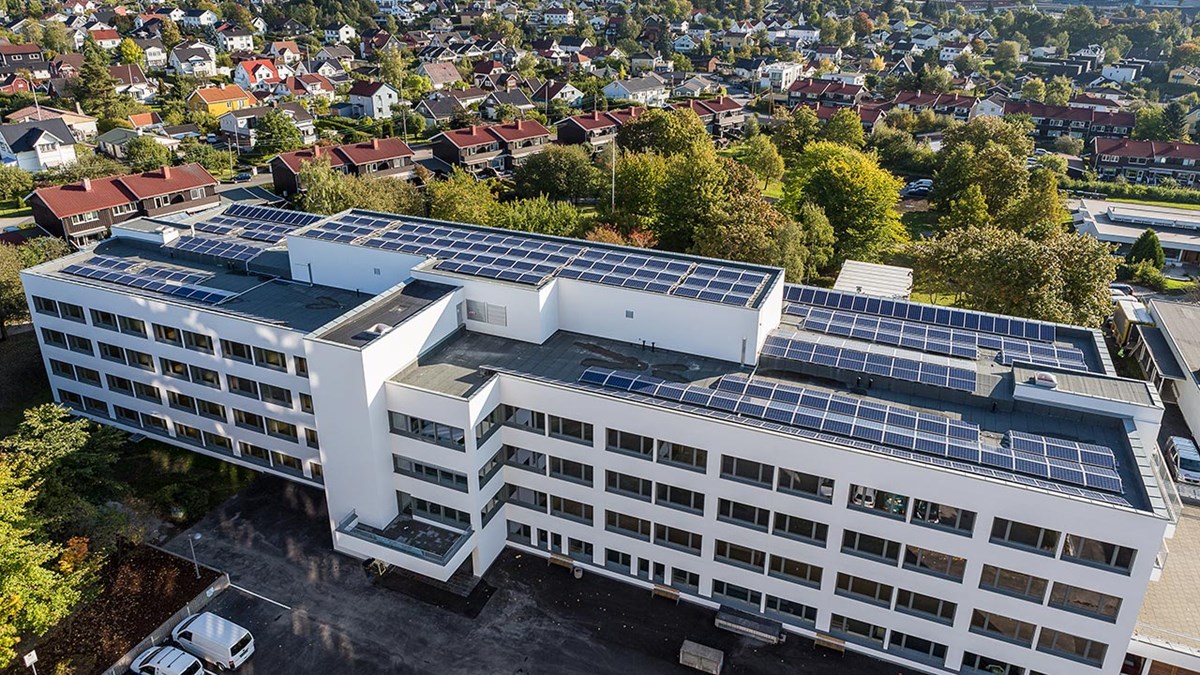Facts about the project
In the Økern Nursing Home project, Omsorgsbygg carried out the following renovation work:
- Renovation of the concrete building envelope, reusing as much material as possible.
- Retrofitting insulation to meet low-energy Category 1 requirements, and installing energy efficient lighting, and replacing technical systems and cloakroom/shower facilities.
- Installation of 790 m2 of photovoltaic panels, which makes this Oslo's biggest solar energy park. Expected production is around 105 Mwh/year. The park supplies 10 per cent of the building's energy needs.
Researchers are studying a small climate revolution
The rapid growth in Tesla vehicles and electric ferries is demonstrating the scale of the green revolution in the transport sector. In only a few years, the majority of vehicles could be electric and green.
However, things are moving much more slowly in the construction industry. Estimates show that 80 per cent of all buildings that will be in use in 2050 have already been built. One in four of these was built before 1950. And it is these old buildings that are preventing politicians achieving their climate objectives.
However, SINTEF researchers have been working with Oslo municipality's Omsorgsbygg agency and are now able to show that there is a way forward. The project studied the renovation of Økern Nursing Home, and shows that:
- Energy requirements have been cut by an impressive 68 per cent compared with original figures, and by 33.5 per cent in relation to a reference building that meets the requirements of the TEK10 Regulations on technical requirements for building works.
- The potential of the improvements can be seen in the statistics showing that buildings represent a surprising 30 per cent of Norwegian greenhouse gas emissions. Økern Nursing Home was built in 1975, and has a capacity of 140 beds occupying a total area of 10,000 square metres. Scaling up the measures could result in a significant reduction in the energy requirements of Norwegian buildings.
- The project has resulted in annual savings of NOK 1.7 million in energy costs, which means that the work will pay for itself in 7.5 years.
Major ripple effects
The project has attracted an enormous amount of attention in Norway, through press coverage and presentations at conferences. It has also achieved energy savings and brought about renewable energy production in other locations:
Part 1: Energy efficiency
- The results of the project generated an increase of NOK 23 million in grants for energy efficiency in nursing homes. The funds have been used to upgrade another four homes, and achieved a total annual reduction in energy requirements of 5 GWh.
- Another NOK 36 million has been allocated towards improving energy efficiency in nursing homes in the 2016 budget.
Part 2: Photovoltaic projects:
- Omsorgsbygg is using the experience gained from this project to plan three more large-scale photovoltaic systems on roofs and façades. Photovoltaic panels are also being installed in more serviced housing units and kindergartens.
- Oslo municipality will be the first to offer an incentive scheme funding photovoltaic panels for private homes.
- The city council has allocated NOK 20 million towards the installation of photovoltaic panels on public buildings.
Total additional costs generated by the project amounted to NOK 16 million. (Enova provided NOK 8 million towards these additional costs).
Norwegian version, click here


